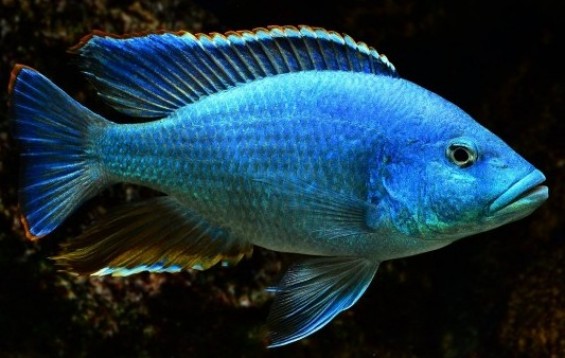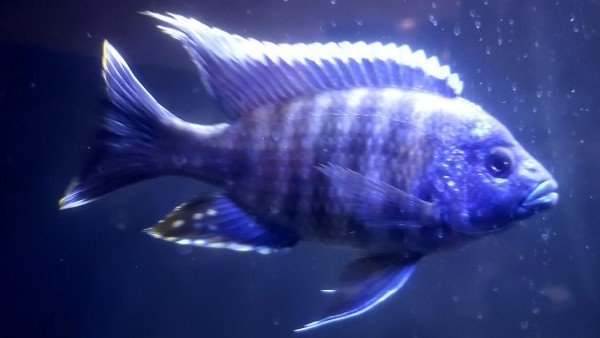- Name:
Livingstons Cichlid
- Family: Cichlidae
- Species: African Cichlids
- Scientific Name: Nimbochromis livingstonii


More Details
General info about Livingstons Cichlid
Livingstons Cichlid (Nimbochromis livingstonii) is a species of African cichlid fish that is native to Lake Malawi in East Africa. It is a large, colorful fish that is a popular choice for aquarium hobbyists. The fish is distinguished by its unique pattern and coloration, which can range from deep blue to bright yellow. It is an omnivore, meaning it feeds on both plant and animal matter, and it requires a warm, well-oxygenated aquarium in order to thrive.
The Livingstons Cichlid is native to Lake Malawi, which is located in East Africa between Malawi, Mozambique, and Tanzania. The fish prefers to inhabit shallow, sandy areas in the lake where it can dig burrows and hide from predators. In the wild, the fish is territorial and may become aggressive when defending its territory. It is also a carnivore and will hunt for smaller fish, crustaceans, and insects.
Livingstons Cichlid Diet & Nutrition
The Livingstons Cichlid is an omnivore, meaning it feeds on both plant and animal matter. A balanced diet should include quality flake food, pellets, frozen foods, live foods, and vegetable-based foods. Feeding a variety of foods will ensure that the fish is getting the nutrients it needs to stay healthy. When feeding Livingstons Cichlid, it is important to feed small amounts several times per day. Overfeeding can lead to water pollution and health problems for the fish. Additionally, foods should be given in a way that encourages natural foraging behavior, such as scattering food across the tank or placing food inside a PVC pipe for the fish to search for. This will help keep the fish active and provide it with mental stimulation.
Determining Sex of Livingstons Cichlid
Male Livingstons Cichlids tend to be larger than females and have longer dorsal fins. Additionally, males will have brighter colors and may have a nuchal hump on the forehead. Males will also be more territorial and aggressive than females and display courtship behaviors such as displaying their colors and chasing other fish. Females, on the other hand, will be more passive and will spend more time hiding and resting.
Breeding & Spawning Livingstons Cichlid
In order to successfully breed Livingstons Cichlid, the aquarium should be set up with the appropriate conditions. This includes a pH level between 7.5 and 8.5, a temperature between 75 and 80 degrees Fahrenheit, and a low nitrate level. Additionally, the aquarium should be well-oxygenated and have plenty of hiding places and caves for the fish to use.
When breeding Livingstons Cichlid, it is important to pair a single male with multiple females. The females will lay eggs on flat rocks or stones and the males will then fertilize them. After the eggs are laid, the parents should be removed from the aquarium as they may eat the eggs. The eggs will hatch after 2 to 3 days and the fry should be fed a diet of baby brine shrimp or other suitable foods.
Common Diseases with Livingstons Cichlid
Livingstons Cichlid can be susceptible to a variety of diseases, including Ich, Velvet, and Hole in the Head. These diseases can be prevented by maintaining a clean aquarium, avoiding overcrowding, and keeping the water parameters within the recommended range.
To prevent diseases from occurring, regular water changes should be performed and the aquarium should be monitored for any signs of illness. Additionally, it is important to quarantine any new fish before introducing them to the tank, as this can help prevent the spread of disease. Finally, any sick or injured fish should be removed from the tank and treated as soon as possible.
Livingstons Cichlid Origin
Livingstons Cichlid is native to Lake Malawi in East Africa, where it inhabits shallow, sandy areas. The lake is known for its abundance of cichlid species, and Livingstons Cichlid is one of the most popular among aquarium hobbyists.
Wild vs. Captive Livingstons Cichlid: While wild Livingstons Cichlids are typically more colorful and larger than their captive counterparts, they are also more aggressive and territorial. Captive Livingstons Cichlids, on the other hand, are typically more passive, making them better suited to life in an aquarium.
Caution with Livingstons Cichlid
Livingstons Cichlid is a large, predatory fish that can be aggressive, especially when defending its territory. As such, it is important to handle the fish with care and avoid overcrowding the aquarium. Additionally, any other fish in the tank should be of similar size and temperament to avoid aggression.
When handling Livingstons Cichlid, it is important to use wet hands to avoid shocking the fish. Additionally, the fish should be gently netted and not grabbed by the tail or fin. Finally, it is important to take care when transferring the fish to a new tank to avoid injuring it.
Acclimating Livingstons Cichlid
Before introducing Livingstons Cichlid to the aquarium, it is important to ensure that the tank is properly set up. This includes having the correct water parameters and providing hiding places, rocks, and plants for the fish to hide in. Additionally, the aquarium should be cycled before adding any fish.
Livingstons Cichlid prefers a pH level between 7.5 and 8.5, a temperature between 75 and 80 degrees Fahrenheit, and a low nitrate level. It is important to test the water regularly to ensure that these parameters are being maintained.
When introducing new fish to the aquarium, it is important to take it slow and allow the fish to adjust to the new environment. This can be done by floating the bag in the aquarium for a few minutes and then releasing the fish. This will help the fish acclimate to the new water conditions and reduce the shock risk.
Relevent Articles
Original Detail
| Name | Species | Family | Scientific Name | More Detail | Added by |
|---|---|---|---|---|---|
| Livingstons Cichlid | African Cichlids | Cichlidae | Nimbochromis livingstonii | Livingstons Cichlid (Nimbochromis livingstonii) is a species of African cichlid fish that is native to Lake Malawi in East Africa. It is a large, colorful fish that is a popular choice for aquarium hobbyists. The fish is distinguished by its unique pattern and coloration, which can range from deep blue to bright yellow. It is an omnivore, meaning it feeds on both plant and animal matter, and it requires a warm, well-oxygenated aquarium in order to thrive. The Livingstons Cichlid is native to Lake Malawi, which is located in East Africa between Malawi, Mozambique, and Tanzania. The fish prefers to inhabit shallow, sandy areas in the lake where it can dig burrows and hide from predators. In the wild, the fish is territorial and may become aggressive when defending its territory. It is also a carnivore and will hunt for smaller fish, crustaceans, and insects. | PalaciosAn |
Changed by users
| Submitted Date | Submitted By | Status | Action |
|---|






